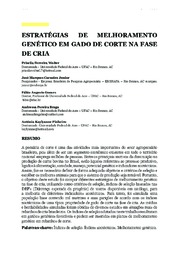Estratégias de melhoramento genético em gado de corte na fase de cria.
Estratégias de melhoramento genético em gado de corte na fase de cria.
Author(s): WOLTER, P. F.; CARNEIRO JUNIOR, J. M.; GOMES, F. A.; BRAGA, A. P.; PINHEIRO, A. K.
Summary: A pecuária de corte é uma das atividades mais importantes do setor agropecuário brasileiro, pois além de ser um segmento econômico existente em todo o território nacional emprega milhões de pessoas. Entre os principais motivos da diminuição na produção de carne bovina no Brasil, estão àqueles referentes ao processo produtivo, ligados à alimentação, sanidade, manejo, potencial genético e indicadores zootécnicos. Assim, faz-se necessário definir, de forma adequada, objetivos e critérios de seleção e escolher os melhores animais para que o sistema de produção seja rentável. Portanto, o objetivo deste estudo foi compor diferentes estratégias de melhoramento genético na fase de cria, utilizando como critérios de seleção, índices de seleção baseados nas DEP's (Diferença esperada da progênie) de touros disponíveis em catálogo, para a melhoria de diferentes indicadores zootécnicos. Para tanto, foi simulada uma população base contendo mil matrizes e suas parições de acordo com os índices zootécnicos de uma típica propriedade de gado de corte na fase de cria. As médiase herdabilidades simuladas foram obtidas de diversos estudos em situações reais de rebanhos de cria brasileiros. Os índices de seleção adotados neste trabalho resultaram em ganhos genéticos favoráveis e podem ser inseridos em planos de melhoramento genético em rebanhos de corte. Cutting livestock farming is one of the most important activities of the Brazilian agricultural sector, as it is an economic segment throughout the country employing millions of people. Among the main reasons for the decrease in beef production in Brazil are those related to the production process, related to food, sanitation, management, genetic potential and zootechnical indicators. Thus, it is necessary to adequatlely define objectives and selection criteria and choose the best animals for the production system to be profitable. Therefore, the objective of this study was to compose different genetic breeding strategies in the breeding phase, using as selection criteria, selection indexes based on the DEPs (Expected Progeny Difference) of available bulls in the catalog, for the improvement of different zootechnical indicators. To do so, a base population containing a thousand matrices and their parisons was simulated according to the zootechnical indexes of a typical beef cattle herd in the breeding phase. Simulated means and heritabilities were obtained from several studies in real situations of Brazilian herds. The selection indexes adopted in this work resulted in favorable genetic gains and can be inserted in plans of genetic improvement in cutting herds.
Publication year: 2019
Types of publication: Journal article
Unit: Embrapa Acre
Observation
Some of Embrapa's publications are published as ePub files. To read them, use or download one of the following free software options to your computer or mobile device. Android: Google Play Books; IOS: iBooks; Windows and Linux: Calibre.
Access other publications
Access the Agricultural Research Database (BDPA) to consult Embrapa's full library collection and records.
Visit Embrapa Bookstore to purchase books and other publications sold by Embrapa.

